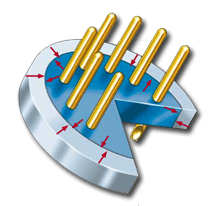Electronics
Mil-QPL and Commercial Hermetic Connectors
Hermetic connectors are designed for use in harsh application environments. Sensitive photographic, sensor and surveillance equipment mounted in the tactical Unmanned Aerial Vehicle for example, must be able to operate in severe weather conditions, at high altitudes, under extremes of atmospheric pressure and in rapidly changing temperature gradients. Hermetic connector devices interconnecting the vacuum sealed black box equipment are selected for their ability to protect the controlled equipment environment by maintaining an air-tight seal between severe flight conditions and aircraft’s sensitive payload.
MIL-DTL-38999 Style Fiber Optic Connection System
Our unique alignment techniques maximize optical performance and provide reliable, repeatable interconnection of optical fibers. Ferrule design, critical to the performance of the termini, has traditionally relied on a machined stainless steel ferrule incorporating a precision micro drilled hole. Our unique precision ceramic ferrules, with concentricity and diametric tolerances controlled within a micron (.00004 of an inch) meet the needs of high bandwidth and low allowable insertion loss applications. In fact, Our ferrules are approximately 10 times more accurate than alternative designs, and have reduced insertion loss values from 1.5dB to less than .5dB (typical loss for our termini is .3 dB).
High Density Fiber Optic Connection System
The High Density Fiber Optic Connector System is designed for applications that require reduced size and weight as well as outstanding optical and environmental performance. The System offers insertion loss values less than .5dB (typical loss for our termini is .3 dB). Dense cavity spacing is acheived with an innovative Front Release terminus design and accomodation for M85045/16 cable.
EMI/EMP Filter Connectors
Designing interconnect systems which deliver clean data streams, undistorted by electromagnetic interference or pulses (EMI/EMP) is an enormous challenge. Electromagnetic Compatibility (EMC) requirements have been established to insure that the performance of an individual electronic device is not degraded due to its proximity to high-frequency electromagnetic interference, and also to prevent the device itself from becoming a potential source of EMI. Sensitive electronic devices also need to be protected from voltage spikes generated during transient states or static discharges in the overall system.



